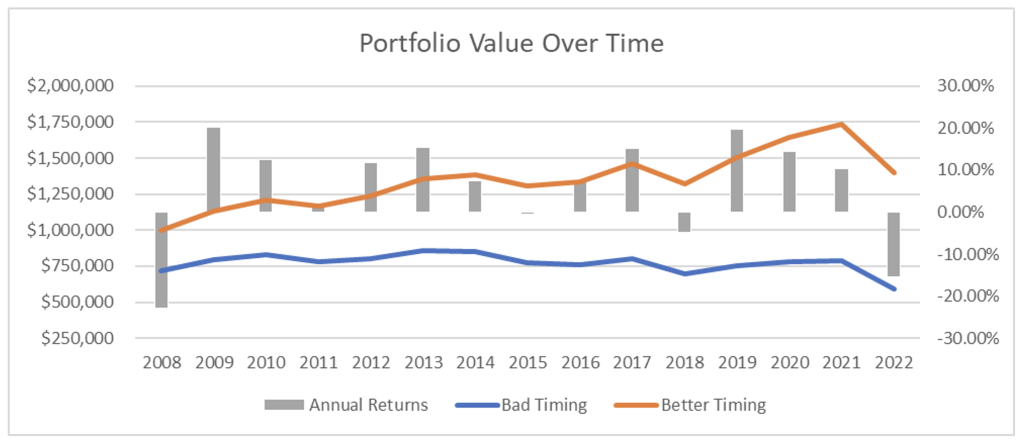
Deciding to retire during market volatility can be a tough call. Do you stick it out for another year, or take the plunge? Even with a well-diversified global portfolio, the timing of retirement can expose an investor to “sequence of return risk,” which is the risk that a market downturn will occur early in retirement. When a portfolio falls in value in the early years of retirement at the same time funds are being withdrawn to meet cash needs, the result is that there are less assets left in the portfolio to compound over time. This can have a significant impact on a portfolio’s longevity.
To illustrate the impact of sequence of return risk, consider the following:
- Dave retires at the end of 2007, just before the financial crisis, with $1,000,000 in his portfolio. His account is invested in a 60% equity/40% bond portfolio throughout his retirement and he withdraws $60,000 per year from the portfolio (as adjusted for a 2% inflation rate). As you can see in the chart below, as represented by the blue line, at the end of 2022, Dave would have approximately $590,000 remaining in his portfolio. His withdrawal rate, at this point, would approximate 13%.
- Dave retires at the end of 2008, with most of the market declines associated with the financial crisis behind us, with the same $1,000,000 in his portfolio. His portfolio is invested as described above and his withdrawal rate is the same. By delaying his retirement by only one year, the results are incredibly different. As you can see in the chart below, as represented by the orange line, at the end of 2022, Dave would have approximately $1.4MM remaining in his portfolio. His withdrawal rate, at this point, would approximate 6%.

Of course we are not able to predict the future, so we cannot know when a market decline will appear. Therefore, for those contemplating retirement, we must plan for the possibility of a market decline in the early years of retirement. Here are some key considerations around how we manage sequence of return risk for our clients:
Understanding Fixed Versus Discretionary Cash Flow Needs
A financially successful retirement typically involves low fixed expenses. That’s why many people aim to pay off their mortgages and other large debts before retiring. Low fixed expenses provide financial flexibility, allowing spending levels and investment account withdrawals to be adjusted throughout retirement.
Stress-Test Financial Projections Prior to Making the Retirement Decision
Prior to making the decision to retire, we work with our clients to prepare and evaluate financial projections that take into account multiple factors including investment returns, spending levels and inflation. We also look at how the results would be impacted if an immediate and significant downturn were to occur. The possibility of this happening and the potential consequences to an overall plan need to be understood. While we will do everything we can to mitigate the impact of a downturn, the projections will provide perspective on what could be so that you can go into retirement with your eyes open.
Dynamic Withdrawal Strategy
Rather than a fixed withdrawal rate, withdrawal rates can be adjusted based on market performance. This may involve withdrawing a smaller percentage during bear markets and a larger percentage during bull markets. Lower withdrawal rates during bear markets put less pressure on a portfolio, limit losses that are locked in and enable a portfolio to participate in the recovery that follows a bear market. It also allows for opportunistic rebalancing; selling well performing positions and using the proceeds to buy into positions that have declined in value so as to “buy low,” as compared to withdrawing cash from sales of well-performing positions to meet cash needs.
Establish a Cash Reserve
A separate cash reserve isn’t just for unexpected expenses. It also helps cover living expenses during market declines. If adequate cash reserves are set aside, investment portfolio withdrawals can be temporarily reduced during downturns. Once the market recovers, cash balances can be replenished.
Diversification
A well-diversified portfolio reduces the impact of a single underperforming asset class on overall returns. Spreading investments across different types of assets, industries, and geographies can help mitigate the risk of a concentrated loss during a market downturn.
At Core Wealth Management, we’re committed to helping you make well-informed financial decisions throughout all market cycles. We’ll help develop a retirement income strategy to position you for success so that when (or if) sequence of return risk presents itself, you will be prepared.
